Structured finance represents an alternative to corporate bonds in the credit portfolio. They offer some combination of:
- Higher yield and expected return.
- Tailored risk exposure through multiple tranches with varying levels of risk ranging from first tranche (often AAA) to mezzanine last tranche, which could be below investment grade and offer higher expected return.
- Exposure to specific market sectors such as real estate, consumer credit, or bank loans that cannot be directly targeted with corporate bonds.
- A diversification benefit. Adding structured finance instruments to a credit portfolio may leave returns unaffected but lower portfolio standard deviation.
There are multiple types of structured finance.
Mortgage-backed securities (MBSs) are pools of mortgage-backed loans. They can be government or privately backed with a range of credit quality and expected return. Compared to corporate bonds:
- Government agency backed MBSs can offer similar yields and spread with greater trading volume and liquidity.
- MBSs have tailored exposure to specific segments of the real estate market. Individual MBSs can be backed by residential or commercial property. (Although some regard certain types of REITS as providing similar exposure, REITS tend to act and be more correlated with the stock market.)
- MBSs are a means of adjusting portfolio exposure to interest rate volatility. Most mortgages and the resulting MBSs offer the borrower the right to prepay the loan. This is economically equivalent to the embedded short call option in a callable bond, but the MBS market is larger, more liquid, and often has less default risk. With decreasing (or increasing) interest rates or an expectation of higher (or lower) interest rate volatility this prepay option becomes more (or less) valuable. Adjusting the level of holdings in MBSs is a way to express a view on future interest rate volatility. This embedded call feature is a reduction in the value of the MBS so increase (or decrease) exposure to MBS if interest rate volatility is expected to decrease (or increase).
- MBSs offer a different exposure to credit risk from that of the corporate bond market. For example, CMBS (MBS backed by commercial real estate loans) are not government agency backed and have credit risk. Suppose OAS on CMBS is higher than normal compared to corporate bonds, and an investor believes real estate prices are likely to improve but corporate profits may be under pressure, it should be profitable to shift out of corporates and into CMBS.
Asset-backed securities (ABSs) are backed by non-mortgage (generally consumer) debt. The collateral can be automobile loans or leases, credit card receivables, student or other personal debt, and accounts receivable. ABSs offer a different source of return and portfolio diversification. Selecting specific types of ABSs (e.g., auto versus student loans) allows the manager to express a view on which sector will provide superior or inferior return.
Collateralized debt obligations (CDOs) are backed by various forms of debt obligations. The CDO collateral is normally some form of corporate debt and CDOs are normally structured in tranches. The most senior tranche is paid first proceeding down to the most junior subordinate tranche which is paid last. Credit quality descends and expected return increases as you move down the tranches. There is little diversification compared to corporate bonds, but the potential benefits include:
- Opportunities to identify relative value. For example, the manager may believe CDOs are cheap or expensive versus corporate bonds, higher or lower quality tranches are misvalued versus each other, or specific types of CDOs such as collateralized loan obligations (CLOs) versus CDOs are misvalued. CLOs are a type of CDO backed by leveraged loans (i.e., use leverage to buy more loans). CLOs generally have high credit quality due to over collateralization and the high quality of the loans held as assets; yet at times they have traded at very high yield.
- Opportunities to express a view on correlation within the underlying collateral. For example, if one manager believes there is +1 correlation between the collateral items then all collateral will default and no tranche can be paid or none will default and all will be paid. That manager should buy the lowest tier tranches to earn the higher expected return as the higher tier tranches are just as likely to default and not be paid. In contrast, a manager who assumes –1 correlation of defaults would buy the highest tier tranche because some collateral will pay and the top tranche will be paid, but some collateral will default and the bottom tranche will not be paid.
- Leveraged exposure to credit risk. The bottom tier tranches of a CDO are akin to a highly leveraged investment in the collateral. If everything works, the return will be high, but if there are losses in the collateral, they may have no value. These tranches may be called the mezzanine or equity tranche.
Covered bonds are bonds that are typically issued by a financial entity such as a bank. They are a form of collateralized debt (backed by specifically identified assets of the issuer) and also general obligations of the issuer. Because of this dual backing, they are considered a lower risk investment than the general bonds of the issuer.
